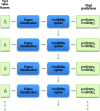Real-time differentiation of adenomatous and hyperplastic diminutive colorectal polyps during analysis of unaltered videos of standard colonoscopy using a deep learning model
- PMID: 29066576
- PMCID: PMC6839831
- DOI: 10.1136/gutjnl-2017-314547
Real-time differentiation of adenomatous and hyperplastic diminutive colorectal polyps during analysis of unaltered videos of standard colonoscopy using a deep learning model
Abstract
Background: In general, academic but not community endoscopists have demonstrated adequate endoscopic differentiation accuracy to make the 'resect and discard' paradigm for diminutive colorectal polyps workable. Computer analysis of video could potentially eliminate the obstacle of interobserver variability in endoscopic polyp interpretation and enable widespread acceptance of 'resect and discard'.
Study design and methods: We developed an artificial intelligence (AI) model for real-time assessment of endoscopic video images of colorectal polyps. A deep convolutional neural network model was used. Only narrow band imaging video frames were used, split equally between relevant multiclasses. Unaltered videos from routine exams not specifically designed or adapted for AI classification were used to train and validate the model. The model was tested on a separate series of 125 videos of consecutively encountered diminutive polyps that were proven to be adenomas or hyperplastic polyps.
Results: The AI model works with a confidence mechanism and did not generate sufficient confidence to predict the histology of 19 polyps in the test set, representing 15% of the polyps. For the remaining 106 diminutive polyps, the accuracy of the model was 94% (95% CI 86% to 97%), the sensitivity for identification of adenomas was 98% (95% CI 92% to 100%), specificity was 83% (95% CI 67% to 93%), negative predictive value 97% and positive predictive value 90%.
Conclusions: An AI model trained on endoscopic video can differentiate diminutive adenomas from hyperplastic polyps with high accuracy. Additional study of this programme in a live patient clinical trial setting to address resect and discard is planned.
Keywords: colorectal adenomas; endoscopic polypectomy; polyp.
© Article author(s) (or their employer(s) unless otherwise stated in the text of the article) 2019. All rights reserved. No commercial use is permitted unless otherwise expressly granted.
Conflict of interest statement
Competing interests: MFB: CEO and shareholder, Satis Operations Inc, ’ai4gi’ joint venture; research support: Boston Scientific. NC: Imagia shareholder, ‘ai4gi’ joint venture. FS: Imagia shareholder, ‘ai4gi’ joint venture. CO: Imagia shareholder, ‘ai4gi' joint venture. FC: Imagia shareholder, ’ai4gi' joint venture. DKR: consultant: Olympus Corp and Boston Scientific; research support: Boston Scientific, Endochoice and EndoAid.
Figures





References
-
- Rex DK, Kahi C, O’Brien M, et al. . The American society for gastrointestinal endoscopy PIVI (Preservation and Incorporation of Valuable Endoscopic Innovations) on real-time endoscopic assessment of the histology of diminutive colorectal polyps. Gastrointest Endosc 2011;73:419–22. 10.1016/j.gie.2011.01.023 - DOI - PubMed
-
- Abu Dayyeh BK, Thosani N, Konda V, et al. . ASGE Technology Committee systematic review and meta-analysis assessing the ASGE PIVI thresholds for adopting real-time endoscopic assessment of the histology of diminutive colorectal polyps. Gastrointest Endosc 2015;81:502.e1–6. 10.1016/j.gie.2014.12.022 - DOI - PubMed
Publication types
MeSH terms
LinkOut - more resources
Full Text Sources
Other Literature Sources
Medical
